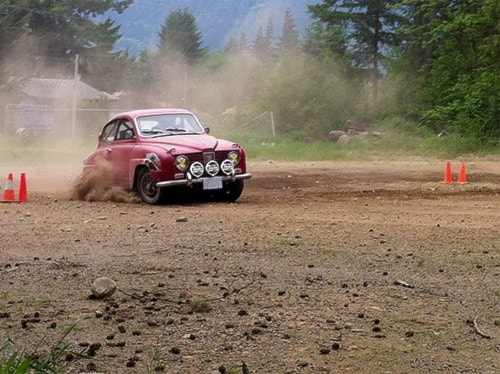Local motorsport fans are in for a treat on June 9 when the West Coast Rally Association brings its rallycross event back to town.
What’s more: for $50.00, licenced drivers can take part in the racing. (If you’re driving your mom’s car, make sure you bring written permission.)
There’s no charge for spectators at the event, which runs from 10 a.m. to 4:30 p.m. in the sports bowl behind the Hope Arena.
If you’re new to the sport of rallycross but would still like to register the top local time, this could be your best opportunity. Hope resident Taisto Heinonen — a five-time Canadian Rally and three-time North American Cup champion — will be away on a cruise, so he won’t be competing in his 1986 Toyota MR2.
Heinonen, who is a WCRA member said, “If you have a car, you can enter. We have ordinary guys off the street — as long as they have an approved helmet and standard seat belts.”
Your car also has to be street-legal and insured. Complete rules are available at the club’s website, www.rallybc.com.
“There are a lot of standard cars,” said Heinonen. “Some are front-wheel drive, some rear-wheel and others are four-wheel drive, such as Subarus and Audis.”
Competition classes are based on the number of driving axles and the tires used.
What is rallycross? Those who have seen the four-wheel drive competitions in the sports bowl may have visions of mud pits, table top jumps and the big hill.
Nope. Mom’s Malibu could handle this.
Heinonen explained that the flat parts of the bowl are used, with pylons marking out the course. It could be a meandering course, or sometimes a figure-eight. No worries on the figure-eight... there’s only one racer at a time. Heinonen figured is usually takes him around a minute-thirty to complete a rallycross run.
Depending on the weather, it could be dusty or muddy — but it will always be a bit rocky and more rutty as the day goes on.
“You get to walk the course first,” said Heinonen, “to help you memorize the turns. Most of it is in first and second gear, so there’s more talent in the turns and staying on the course.”
Poke a pylon or run off course and you gain time penalties, or get a disqualification on that run.
Heinonen said there’s plenty of seating for spectators on the hillsides facing the sports bowl. There’s also a viewing area on the gravel road at the top.
“All the cars start up there, so people can walk around and look at them,” said the Finnish-born Heinonen. Racing groups are called down for their event and they use Sixth Avenue and Hudson Bay Street to get to the track and back.
“Sometimes, we’ll have 12 or 14 cars entered, or up to 25,” said Heinonen. “They come from Prince George, Kamloops, Kelowna, the Lower Mainland and Washington state.
“They usually get four runs each in the morning, then we change the course for the afternoon and they do four runs again.”
Club member Darsi Sullivan is helping organize the rallycross, but she’s also involved in a road rally, which begins and ends in Hope on the June 15-16 weekend.
“What you usually see on TV is called a stage rally,” she said. This one is called a TSD, or time-speed-distance rally. It’s all on public roads... about 80 per cent of them gravel... and all at below posted speed limits.
“It’s approximately 500 kilometres long and we have a fuel stop in Merritt. We’re gathering at Rolly’s restaurant, from 5-9 on Saturday night, then arriving back there on Sunday morning at around seven,” said Sullivan. “It’s one of the longest days and shortest nights of the year — but most of it will be done in the dark.”
If you’ve got the money for fuel — and the $90 entry fee — this could be a good starting point for road rally novices.
“You can absolutely come out and do it in your daily driver car,” said Sullivan. “No helmets are required, though the car must be insured. If you can read and follow directions, you could do it.”
Better yet: bring a literate friend to be your navigator.
Everybody gets a number badge for their car and a route book, which could have 20 pages or more of textual instructions and a few diagrams for intersections, explained Sullivan.
“You follow the route and try to arrive at the check points exactly on-time, to get the lowest amount of points,” said Sullivan. “Lowest points win, like in golf.”
